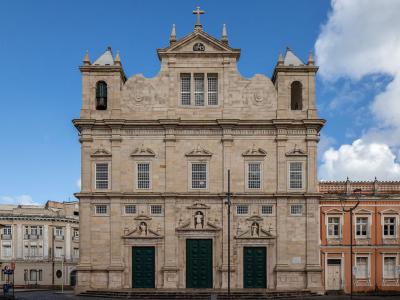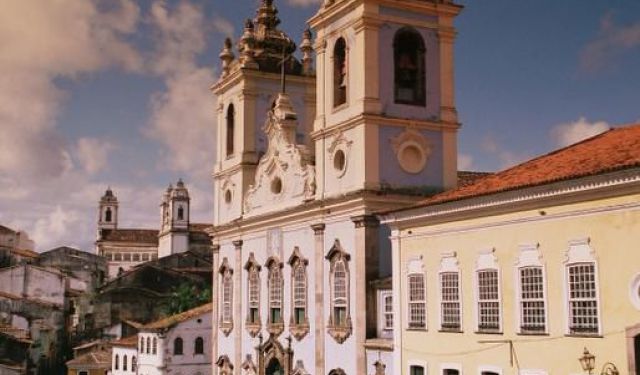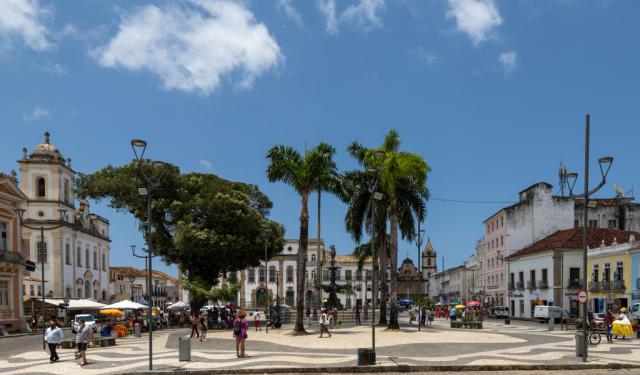Catedral Basilica de Salvador (Cathedral Basilica of Salvador), Salvador (must see)
The 17th-century Cathedral Basilica, also known as the “Sé,” is the undisputed matriarch of Brazilian Catholic churches. A heady mix of Baroque, Rococo, and Neoclassical flair, this architectural diva was originally built as part of a Jesuit monastic and educational complex. Built from sandstone blocks shipped all the way from Portugal, its history took a dramatic turn in the 1620s when the Dutch captured it, turned it into a warehouse, and made off with its silver finery. After the Portuguese regained control, the church was rebuilt in a Mannerist style to mimic the Jesuit Church of Coimbra back in Portugal. Even a devastating fire in the early 1900s could not hold it down; by 1933, it was restored once more, proving it’s as indestructible as it is elegant.
Step inside and you’re treated to a feast of colonial opulence: 16th-century tiles in the sacristy shipped from Macau, intricate ivory and tortoiseshell inlays from Goa on the third altar on the right, and enough gold leaf to dazzle the eye at every turn. Indeed, the church’s 13 gold-plated altars are a stunning display, covered in over 50,000 gold leaves, 5,000 silver leaves, and shaped by countless hours of skilled craftsmanship.
If that’s not enough, you’ll be treated to a gallery of 17th-century paintings, 30 carefully restored reliquary busts, and two exquisite altars that rank among the finest examples of late 16th-century Brazilian sacred art. The nave, crowned with the Latin inscription “IHS” (Jesus Humanity Savior), was painstakingly assembled over two years by five master carpenters using four shiploads of noble woods. Clearly, no expense-or effort-was spared.
As the glittering centerpiece of Salvador’s UNESCO-listed Historic Center, this cathedral rolls out the red carpet for history buffs and art lovers.
Step inside and you’re treated to a feast of colonial opulence: 16th-century tiles in the sacristy shipped from Macau, intricate ivory and tortoiseshell inlays from Goa on the third altar on the right, and enough gold leaf to dazzle the eye at every turn. Indeed, the church’s 13 gold-plated altars are a stunning display, covered in over 50,000 gold leaves, 5,000 silver leaves, and shaped by countless hours of skilled craftsmanship.
If that’s not enough, you’ll be treated to a gallery of 17th-century paintings, 30 carefully restored reliquary busts, and two exquisite altars that rank among the finest examples of late 16th-century Brazilian sacred art. The nave, crowned with the Latin inscription “IHS” (Jesus Humanity Savior), was painstakingly assembled over two years by five master carpenters using four shiploads of noble woods. Clearly, no expense-or effort-was spared.
As the glittering centerpiece of Salvador’s UNESCO-listed Historic Center, this cathedral rolls out the red carpet for history buffs and art lovers.
Want to visit this sight? Check out these Self-Guided Walking Tours in Salvador. Alternatively, you can download the mobile app "GPSmyCity: Walks in 1K+ Cities" from Apple App Store or Google Play Store. The app turns your mobile device to a personal tour guide and it works offline, so no data plan is needed when traveling abroad.
Catedral Basilica de Salvador (Cathedral Basilica of Salvador) on Map
Sight Name: Catedral Basilica de Salvador (Cathedral Basilica of Salvador)
Sight Location: Salvador, Brazil (See walking tours in Salvador)
Sight Type: Religious
Guide(s) Containing This Sight:
Sight Location: Salvador, Brazil (See walking tours in Salvador)
Sight Type: Religious
Guide(s) Containing This Sight:
Walking Tours in Salvador, Brazil
Create Your Own Walk in Salvador
Creating your own self-guided walk in Salvador is easy and fun. Choose the city attractions that you want to see and a walk route map will be created just for you. You can even set your hotel as the start point of the walk.
Salvador's Historical Churches Tour
In Salvador, Brazil, there are quite a few churches emblematic of its cultural and religious heritage. The city's historic district contains so many old Catholic temples that some even joke that you can have a different church to visit there every day of the year. However, if you don't have a whole year to spend in Salvador but still want to make the most of your time in terms of... view more
Tour Duration: 1 Hour(s)
Travel Distance: 2.1 Km or 1.3 Miles
Tour Duration: 1 Hour(s)
Travel Distance: 2.1 Km or 1.3 Miles
Salvador Introduction Walking Tour
Salvador is a coastal city in Brazil. Founded in 1548, it is the country's former capital and serves as the current capital of the state of Bahia. It is one of the oldest planned cities in the Americas.
Due to its location, early Europeans turned Salvador into an important trade route for slavery. Of the nearly 5 million enslaved people who were imported to Brazil, about 1.3 million were... view more
Tour Duration: 1 Hour(s)
Travel Distance: 1.6 Km or 1 Miles
Due to its location, early Europeans turned Salvador into an important trade route for slavery. Of the nearly 5 million enslaved people who were imported to Brazil, about 1.3 million were... view more
Tour Duration: 1 Hour(s)
Travel Distance: 1.6 Km or 1 Miles





